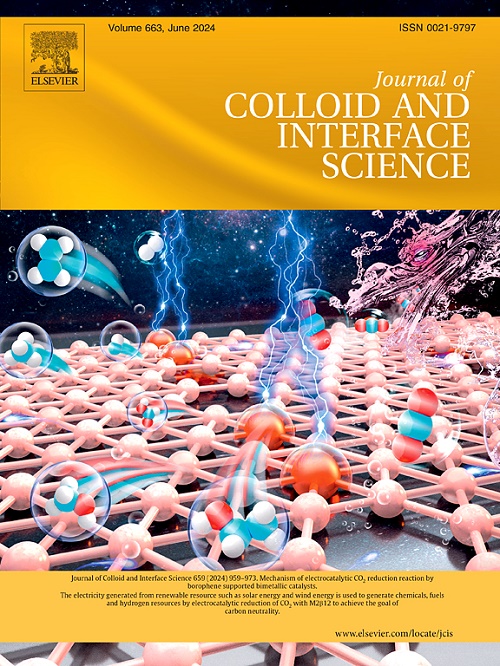中空双面结构NiCoP/P-MoS2异质结作为自支撑电极的界面工程可以促进碱性析氢反应。
IF 9.7
1区 化学
Q1 CHEMISTRY, PHYSICAL
引用次数: 0
摘要
过渡金属磷(TMPs)和硫化物作为取代贵金属基析氢(HER)催化剂的重要候选物受到了广泛的关注。但其比表面积不足、电导率低、电极易脱落等缺点严重影响了HER的催化活性和稳定性。本文在碳布(CC)上设计了一种新型的自支撑空心janus结构NiCoP/P-MoS2异质结,作为碱性HER的高性能电催化剂。无粘结剂NiCoP/P-MoS2/CC电极具有分散良好的空心结构,具有良好的耐久性和较低的过电位,达到10 mA cm-2所需过电位为52.6 mV,远优于NiCoP/CC (111.2 mV)、P-MoS2/CC (213.3 mV)电极和相应的NiCoP/P-MoS2粉末催化剂(113.1 mV)。实验和理论结果证实,异质界面相互作用可以改善电子态,加速电荷转移,优化氢吸附能,从而提高HER动力学过程。此外,自支撑策略有利于高质量活性物质紧密锚定,具有良好的空心阵列结构,显著防止催化剂团聚和脱落,从而提高HER稳定性。这项工作为研究催化机理提供了有价值的见解,并为设计高效稳定的HER电催化剂的分层结构提供了途径。本文章由计算机程序翻译,如有差异,请以英文原文为准。

Interface engineering of hollow Janus-structured NiCoP/P-MoS2 heterojunction as self-supported electrode enables boosted alkaline hydrogen evolution reaction
Transition metal phosphorus (TMPs) and sulfides have attracted extensive attention as important candidates to replace noble metal-based hydrogen evolution (HER) catalysts. However, the insufficient specific surface area, low conductivity and easy detachments from electrode seriously affect the HER catalytic activity and stability. Herein, a novel self-supported hollow Janus-structured NiCoP/P-MoS2 heterojunction is designed on carbon cloth (CC) as high-performance electrocatalyst for alkaline HER. The binder-free NiCoP/P-MoS2/CC electrode with well-dispersed hollow structure exhibits acceptable durability and low overpotential, which requires overpotential of 52.6 mV to reach 10 mA cm−2, far superior to that of NiCoP/CC (111.2 mV), P-MoS2/CC (213.3 mV) electrode and also the corresponding NiCoP/P-MoS2 powder catalyst (113.1 mV). Experimental and theoretical results confirm that heterointerface interaction can improve the electronic state, accelerate charge transfer and optimize hydrogen adsorption energy, resulting in boosted HER kinetic process. Additionally, self-supported strategy is conducive to tightly anchoring high-quality active substances with well-organized hollow array structure, which significantly prevents the catalyst agglomeration and shedding, leading to the improved HER stability. This work offers valuable insights into the catalytic mechanisms and provides an avenue for designing hierarchical architecture for highly efficient and stable HER electrocatalysts.
求助全文
通过发布文献求助,成功后即可免费获取论文全文。
去求助
来源期刊
CiteScore
16.10
自引率
7.10%
发文量
2568
审稿时长
2 months
期刊介绍:
The Journal of Colloid and Interface Science publishes original research findings on the fundamental principles of colloid and interface science, as well as innovative applications in various fields. The criteria for publication include impact, quality, novelty, and originality.
Emphasis:
The journal emphasizes fundamental scientific innovation within the following categories:
A.Colloidal Materials and Nanomaterials
B.Soft Colloidal and Self-Assembly Systems
C.Adsorption, Catalysis, and Electrochemistry
D.Interfacial Processes, Capillarity, and Wetting
E.Biomaterials and Nanomedicine
F.Energy Conversion and Storage, and Environmental Technologies

 求助内容:
求助内容: 应助结果提醒方式:
应助结果提醒方式:


